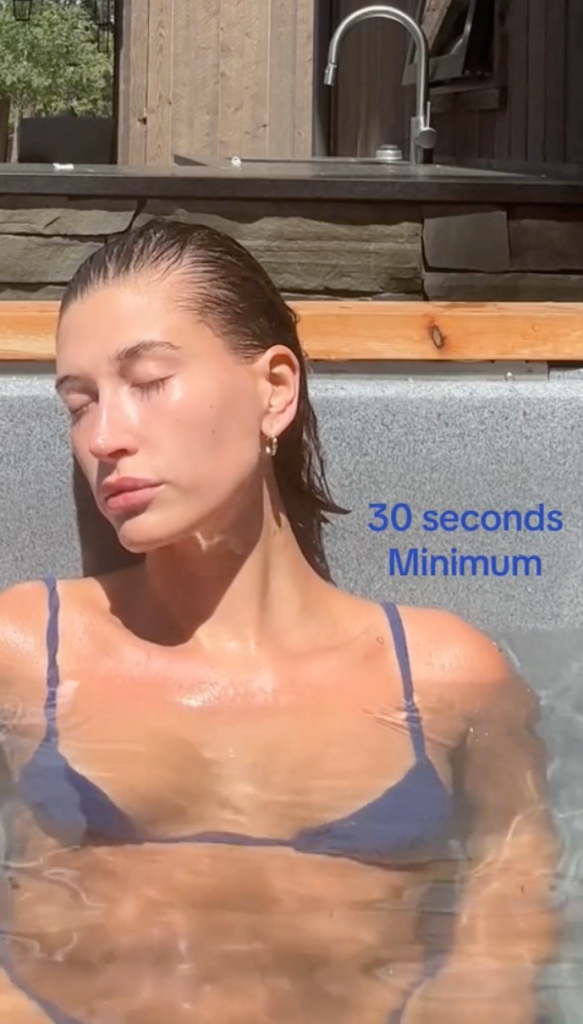Hailey Bieber says cold plunging helped anxiety, experts weigh in
Hailey Bieber has a new method to help with anxiety: a cold water plunge.
The 26-year-old model posted a video to TikTok showing her process of going into a plunge pool filled with cold water.
Bieber wrote that she stays in for 30 seconds minimum, and she’s seen in the video shoulder-deep in the water taking deep breaths as she adjusts to the temperature.
At the end, she holds her nose and dunks her head underwater before she gets out and finishes the plunge.
The Rhode Beauty founder wrote in the caption of the video that “cold plunging has helped me a lot with anxiety and overall mood.”
Bieber isn’t the only celeb that loves an icy plunge.
Actor Josh Brolin, 55, and his wife Kathryn Boyd are into cold plunging, as is Zac Efron, 35. Lady Gaga, 37, has shared that she takes 5 to 10 minute ice baths as part of her post-show routine.
Cold plunging in an ice bath is also a common practice as a post-game treatment for athletes, but is the tactic really helpful for all?
While there may be minor benefits to cold water therapy, research on the advantages is sparse.
“Nobody knows exactly why it even helps you,” Dr. Tracy Zaslow, a primary care sports medicine physician at the Cedars-Sinai Kerlan-Jobe Institute said in a blog post. “Maybe it’s changes in adrenaline or cortisol — or even dopamine. There are a lot of hypotheses, as opposed to data.”
Possible health benefits of cold water therapy include exercise recovery, pain reduction, improving circulation, boosting mood and building resilience, according to a medically reviewed article in Everyday Health.
But of all the possibilities, the one backed with the most evidence is soothing sore muscles.
“There have been a couple of studies showing that there may be some decreased soreness after people were immersed in cold water for about 10 minutes versus those who did not do any cold therapy,” Zaslow said. “When you’re in cold water, your blood vessels constrict so there’s less blood flow to the area, then there’s less swelling and inflammation leading to less pain.”
As for helping with mood and anxiety as Bieber claims, this has yet to be scientifically proven.
A study published in February 2000 in the European Journal of Applied Physiology suggested that immersion into cold water can increase dopamine concentration by 250%, but Zaslow feels more research needs to be conducted in order to prove the correlation.
“The study that showed it might be helpful for mental health looked at people who took a course in swimming in cold seawater,” Zaslow said. “But exercise can improve your mood and well-being. To me, it’s a soft case that it was the cold water providing the aid.”

Additionally, the American Heart Association has warned against the risks of a cold plunge, suggesting that “you are not a polar bear.”
Sudden plunging into cold temperature waters can cause what’s known as the “cold shock response” — a sudden, rapid increase in breathing, heart rate and blood pressure, which can cause a person to drown if they involuntarily gasp while submerged. Since the shock adds additional pressure to the heart and causes it to work harder, this practice is especially dangerous for those with a history of cardiac issues.
Lee Hill, an exercise scientist and a postdoctoral fellow at the Research Institute of the McGill University Health Center in Quebec, Canada, told the AHA that the risk of hypothermia continues after getting out of the cold water, so it’s vital to immediately get out of the cold, wet clothes and change into warm ones.

The National Center for Cold Water Safety cautions that immersion in cold water under 60 degrees Fahrenheit can kill a person in less than a minute.
Other than a cold shock response and hypothermia, risks of exposure to cold temperatures can include frostbite, heart arrhythmias and even heart attacks, according to the AHA.
Zaslow suggests that, like all fitness and health trends, one should consult their doctor before taking part.
“It’s not a completely benign activity,” Zaslow said. “Talk to your doctor to make sure that no harm comes from a fun activity that is intended to help your health.”
Read the full article Here


